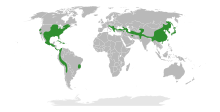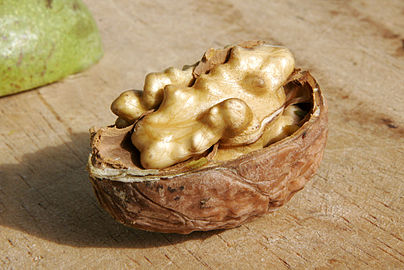Juglandaceae
| Juglandaceae | |
|---|---|

| |
| Juglans regia | |
| Scientific classification | |
| Kingdom: | Plantae |
| Clade: | Tracheophytes |
| Clade: | Angiosperms |
| Clade: | Eudicots |
| Clade: | Rosids |
| Order: | Fagales |
| Family: | Juglandaceae DC. ex Perleb[1] |
| Type genus | |
| Juglans | |
| Subfamilies | |
|
See text | |

| |
| The range of subfamily Engelhardioideae | |

| |
| The range of subfamily Juglandoideae | |
| Synonyms[2] | |
| |
The Juglandaceae are a plant family known as the walnut family. They are trees, or sometimes shrubs, in the order Fagales. Members of this family are native to the Americas, Eurasia, and Southeast Asia.
The nine or ten genera in the family have a total of around 50 species,[3] and include the commercially important nut-producing trees walnut (Juglans), pecan (Carya illinoinensis), and hickory (Carya). The Persian walnut, Juglans regia, is one of the major nut crops of the world. Walnut, hickory, and gaulin are also valuable timber trees while pecan wood is also valued as cooking fuel.
Description[]
Members of the walnut family have large, aromatic leaves that are usually alternate, but opposite in Alfaroa and Oreomunnea. The leaves are pinnately compound or ternate, and usually 20–100 cm long. The trees are wind-pollinated, and the flowers are usually arranged in catkins.
The fruits of the Juglandaceae are often confused with drupes but are accessory fruit because the outer covering of the fruit is technically an involucre and thus not morphologically part of the carpel; this means it cannot be a drupe but is instead a drupe-like nut.[4]

Nut of Juglans regia

Foliage and seed catkin of Platycarya strobilacea
Taxonomy[]
The known living genera are grouped into subfamilies, tribes, and subtribes as follows:[5]
- Subfamily Rhoipteleoideae Reveal
- Rhoiptelea Diels & Hand.-Mazz. 1932[6]
- Subfamily Iljinskaya 1990
- Alfaroa Standl. 1927—gaulin
- Engelhardia Lesch. ex Blume 1825–1826—cheo
- Oreomunnea Oerst. 1856
- Subfamily Juglandoideae Eaton 1836
- Tribe Platycaryeae Nakai 1933
- Platycarya Siebold & Zucc. 1843
- Tribe Juglandeae Rchb. 1832
- Subtribe Caryinae D.E. Stone & P. S. Manos 2001
- Carya Nutt. 1818—hickory and pecan
- Annamocarya A.Chev. 1941 (sometimes included in Carya)
- Subtribe Juglandinae D.E. Stone & P. S. Manos 2001
- Cyclocarya Iljinsk 1953—wheel wingnut
- Juglans L. 1753—walnut
- Pterocarya Kunth 1824—wingnut
- Subtribe Caryinae D.E. Stone & P. S. Manos 2001
- Tribe Platycaryeae Nakai 1933
Systematics[]
Modern molecular phylogenetics suggest the following relationships:[7]
| |||||||||||||||||||||||||||||||||||||||||||||||||||||||||||||
References[]
| Wikisource has the text of the 1920 Encyclopedia Americana article Juglandacæ. |
- ^ Angiosperm Phylogeny Group (2009). "An update of the Angiosperm Phylogeny Group classification for the orders and families of flowering plants: APG III" (PDF). Botanical Journal of the Linnean Society. 161 (2): 105–121. doi:10.1111/j.1095-8339.2009.00996.x. Retrieved 2013-07-06.
- ^ "Family: Juglandaceae DC. ex Perleb, nom. cons". Germplasm Resources Information Network. United States Department of Agriculture. 2003-01-17. Archived from the original on 2015-10-03. Retrieved 2011-11-17.
- ^ Christenhusz, M. J. M.; Byng, J. W. (2016). "The number of known plants species in the world and its annual increase". Phytotaxa. 261 (3): 201–217. doi:10.11646/phytotaxa.261.3.1.
- ^ John Derek Bewley, Michael Black, Peter Halmer (2006) The Encyclopedia of Seeds: Science, Technology And Uses
- ^ Manos, P. S.; D. E. Stone (2001). "Evolution, phylogeny and systematics of the Juglandaceae" (PDF). Annals of the Missouri Botanical Garden. 88 (2): 231–269. doi:10.2307/2666226. JSTOR 2666226.
- ^ "GRIN Genera of Juglandaceae". Germplasm Resources Information Network. United States Department of Agriculture. Archived from the original on 2015-09-24. Retrieved 2011-11-17.
- ^ Xiang XG, Wang W, Li RQ, Lin L, Liu Y, Zhou ZK, Li ZY, Chen ZD (2014). "Large-scale phylogenetic analyses reveal fagalean diversification promoted by the interplay of diaspores and environments in the Paleogene". Perspectives in Plant Ecology, Evolution and Systematics. 16 (3): 101–110. doi:10.1016/j.ppees.2014.03.001.
- Juglandaceae
- Rosid families


